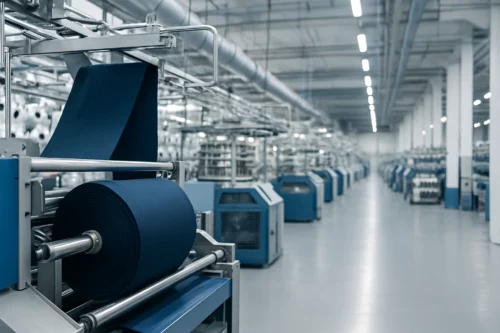Circular Fashion: A Guide to the Future of Sustainable Style

In this guide, we’ll break down what circular fashion really means, how it supports the broader circular economy, and how companies working with bluesign are already putting these principles into practice.
The Current State of Fashion
Today’s mainstream fashion system is built on a linear model: produce, consume, discard. Fashion brands are complicit, often placing orders for massive volumes of clothing in order to achieve the lowest per-piece rate from suppliers (overstocking), while encouraging short-term use and rapid turnover among consumers (overconsumption).
Available statistics suggest that between 10% and 40% of garments made are not sold, resulting in a textile waste problem. In addition, studies have shown that the average garment today has a shorter lifespan, with the average garment only being worn three and seven times in China and the UK respectively before being tossed out. Globally, an estimated 92 million tons of textile waste is generated each year, while less than 1% of used clothes are recycled into new clothes in a closed-loop process.
The linear model relies heavily on virgin materials, hazardous chemicals, and energy-intensive processes. It contributes to water pollution, high carbon emissions, and unethical labor practices. In contrast, circular fashion offers a restorative solution that keeps materials in use and reduces the industry’s environmental impact.
What Is Circular Fashion?
Circular fashion is an approach to design and production that ensures clothing stays in use for as long as possible. It’s built around reuse, repair, resale, recycling, and regeneration. Unlike the linear model, circular fashion is designed to eliminate waste and pollution from the beginning.
Key principles include:
- Durability: Designing high-quality garments that last
- Repairability: Making it easy to fix and extend use
- Recyclability: Creating garments that can be safely disassembled and reprocessed
bluesign recognizes the importance of circular fashion and has thus introduced Sustainability Attributes for bluesign Approved Chemical Products in 2023. Of the three attributes available, one relates to renewable feedstock to promote the transition away from fossil-fuel sources, while another relates to recycled content to reduce reliance on virgin raw materials.
Circular Fashion and the Circular Economy
A circular economy is a system that keeps resources in use through continuous loops. In fashion, this means garments are designed, worn, reused, and recycled, reducing the need for new materials and minimizing environmental impact.
Circular fashion fits perfectly into this model. Strategies like fiber-to-fiber recycling, repair and take-back programs, resale and rental platforms, and modular design help reduce textile waste while creating new value.
Benefits of Circular Fashion
The environmental and ethical challenges in fashion are urgent. Circular fashion addresses many of them:
- Reduces waste by extending the life of garments
- Allows green growth by decoupling profit from production
- Conserves resources like virgin raw materials, water and energy
- Encourages innovation through new business models and design strategies
Circularity also resonates with consumers, who are increasingly looking for sustainable, transparent brands. It builds loyalty, reduces long-term costs, and aligns with global sustainability goals.
Circular Fashion in Practice: Real-World Brand Examples
Many bluesign System Partners are already proving that circular fashion is both achievable and scalable:
- Patagonia offers repair and trade-in through Worn Wear since 2012. It is estimated that Patagonia has sold 120,000 repurposed items as of 2020.
- Eileen Fisher runs a Renew program focused on reuse and upcycling.
- Deuter offers a lifelong repair service.
- Vaude integrates repair, rental, and closed-loop design into its operations.
- adidas developed the Futurecraft Loop – a performance shoe made entirely from one material, designed to be returned and remade.
- The North Face runs a Renewed resale program and long-standing product warranty services.
- Houdini Sportswear shares open-source circularity tools and encourages customers to rent instead of buy.
- Reformation focuses on timeless design, low-impact materials, and circular strategies like fabric recycling.
These System Partner brands show that circularity can be applied across product categories, price points, and customer experiences, setting a strong foundation for a more sustainable industry.
Circular Business Models
Circular fashion thrives on innovation. Several business models help drive this shift:
- Resale platforms: Brands resell secondhand clothing via their own platforms, resale-as-a-service solution providers or third-party marketplaces.
- Rental programs: Consumers can rent pieces for special occasions or seasonal use, reducing the need to buy new.
- Repair services: In-house or partner-based repairs keep clothing wearable for longer.
- Take-back initiatives: Customers return old garments for recycling.
bluesign System Partners like Vaude, Patagonia, and The North Face use these models not only to reduce waste and deepen customer engagement and loyalty, but also to diversify their revenue stream and future-proof their business.
Circular Design in Fashion
Circularity starts with design. Creating garments that can be reused, repaired, or safely recycled requires thoughtful material selection and construction.
Examples include:
- adidas: Mono-material construction for recyclability
- Arc’teryx: Durable, repairable products built to withstand years of use
- Eileen Fisher: Minimalist, modular designs made from bluesign-approved fabrics
- Helly Hansen: Robust outdoor gear with extended warranties and product traceability
- Isbjörn of Sweden: Kids’ outerwear built to last through multiple owners
bluesign supports more sustainable product design by helping brands evaluate and improve chemical inputs, material choices, and resource use at the manufacturing stage. While not specific to circular design alone, this upstream approach contributes to safer, lower-impact production processes that align with the broader goals of circularity.
What You Can Do: Conscious Choices for Circular Style
Consumers play a crucial role in making fashion more circular. Here are a few ways to contribute:
- Buy less, choose well. Reconsider the necessity of every purchase. Invest in long-lasting, high-quality pieces and prioritize secondhand whenever possible.
- Support circular brands. Look for resale, rental, repair or take-back programs – many bluesign System Partners offer them.
- Repair and reuse. Learn basic clothing care and mending skills. Visit your local tailor for complicated repairs.
- Resell or swap. Keep garments in use by giving them a second life.
- Ask questions. Demand transparency from brands on materials, sourcing, and sustainability.
Want to learn more? Explore our guides on PFAS in clothing and ethical fashion to better understand the chemicals, processes, and values behind your clothes.
Sources
- adelphi & GIZ. Circular Economy in the Textile Sector. [PDF] https://adelphi.de/en/system/files/mediathek/bilder/GIZ_Studie_Kreislaufwirtschaft_Textilsektor_2019_final.pdf
- Wall Street Journal. The High Price of Fast Fashion. https://www.wsj.com/articles/the-high-price-of-fast-fashion-11567096637
- The Guardian. Why Fashion’s Waste Crisis Is the Industry’s Dirty Secret. https://www.theguardian.com/fashion/2024/jan/18/its-the-industrys-dirty-secret-why-fashions-
- United Nations Environment Programme (UNEP). Unsustainable Fashion and Textiles in the Spotlight on International Day of Zero Waste. https://www.unep.org/news-and-stories/press-release/unsustainable-fashion-and-textiles-focus-international-day-zero
- The Manual. Patagonia’s Worn Wear Collection Redefines Outdoor Recommerce. https://www.themanual.com/outdoors/oatagonia-worn-wear-collection-recycled-recommerce/



